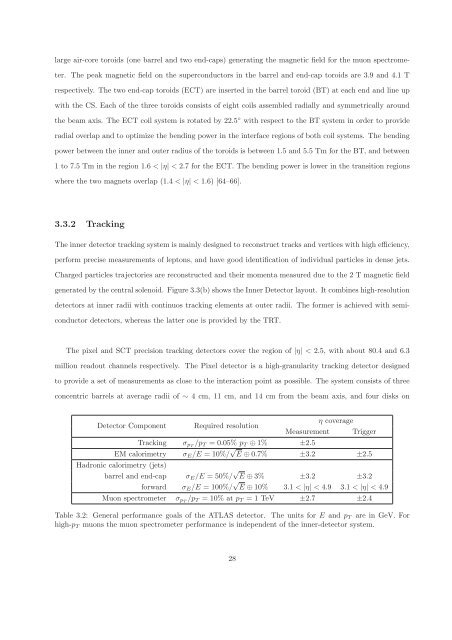CERN-THESIS-2012-153 26/07/2012 - CERN Document Server
CERN-THESIS-2012-153 26/07/2012 - CERN Document Server
CERN-THESIS-2012-153 26/07/2012 - CERN Document Server
You also want an ePaper? Increase the reach of your titles
YUMPU automatically turns print PDFs into web optimized ePapers that Google loves.
large air-core toroids (one barrel and two end-caps) generating the magnetic field for the muon spectrome-<br />
ter. The peak magnetic field on the superconductors in the barrel and end-cap toroids are 3.9 and 4.1 T<br />
respectively. The two end-cap toroids (ECT) are inserted in the barrel toroid (BT) at each end and line up<br />
with the CS. Each of the three toroids consists of eight coils assembled radially and symmetrically around<br />
the beam axis. The ECT coil system is rotated by 22.5 ◦ with respect to the BT system in order to provide<br />
radial overlap and to optimize the bending power in the interface regions of both coil systems. The bending<br />
power between the inner and outer radius of the toroids is between 1.5 and 5.5 Tm for the BT, and between<br />
1 to 7.5 Tm in the region 1.6 < |η| < 2.7 for the ECT. The bending power is lower in the transition regions<br />
where the two magnets overlap (1.4 < |η| < 1.6) [64–66].<br />
3.3.2 Tracking<br />
The inner detector tracking system is mainly designed to reconstruct tracks and vertices with high efficiency,<br />
perform precise measurements of leptons, and have good identification of individual particles in dense jets.<br />
Charged particles trajectories are reconstructed and their momenta measured due to the 2 T magnetic field<br />
generated by the central solenoid. Figure 3.3(b) shows the Inner Detector layout. It combines high-resolution<br />
detectors at inner radii with continuos tracking elements at outer radii. The former is achieved with semi-<br />
conductor detectors, whereas the latter one is provided by the TRT.<br />
The pixel and SCT precision tracking detectors cover the region of |η| < 2.5, with about 80.4 and 6.3<br />
million readout channels respectively. The Pixel detector is a high-granularity tracking detector designed<br />
to provide a set of measurements as close to the interaction point as possible. The system consists of three<br />
concentric barrels at average radii of ∼ 4 cm, 11 cm, and 14 cm from the beam axis, and four disks on<br />
Detector Component Required resolution<br />
Tracking σpT /pT = 0.05% pT ⊕ 1% ±2.5<br />
η coverage<br />
Measurement Trigger<br />
EM calorimetry σE/E = 10%/ √ E ⊕ 0.7% ±3.2 ±2.5<br />
Hadronic calorimetry (jets)<br />
barrel and end-cap σE/E = 50%/ √ E ⊕ 3% ±3.2 ±3.2<br />
forward σE/E = 100%/ √ E ⊕ 10% 3.1 < |η| < 4.9 3.1 < |η| < 4.9<br />
Muon spectrometer σpT /pT = 10% at pT = 1 TeV ±2.7 ±2.4<br />
Table 3.2: General performance goals of the ATLAS detector. The units for E and pT are in GeV. For<br />
high-pT muons the muon spectrometer performance is independent of the inner-detector system.<br />
28















